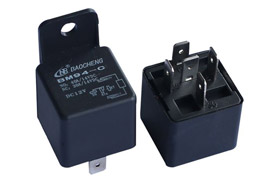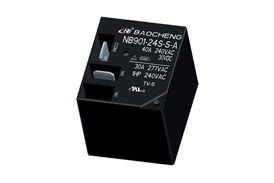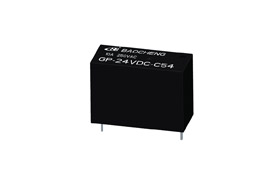Like other components in the electronics industry, power relay technology is moving forward. Current trends in power relays include lower profile packages, less real estate, low input power, higher switching power, higher electrical isolation and higher ambient temperature operation. The above trends are pushing the development of what relays can do in terms of material research, manufacturing techniques and advanced computer aided modeling principles.
In terms of size, we see the relay height and overall volume dropping, due to the fact that customers must fit more electronics on their PC boards. The higher electronic content is a direct result of adding more functionality and product features to the end product. With more functionality, this creates the use of more relays, which once again necessitate smaller relays. Also, in terms of height, we see the industry moving to thinner control panel designs. The need for relay input power to be lower is also important. The drivers for this trend involve less heat and lower cost drivers for the relay coil (input). As the coil power goes up, the coil heat generation goes up; thus, the problem of thermal management is more costly. In addition, as relay heat generation goes up, higher-grade insulation systems must be employed. Also, the cost of power and power management is going up; this involves the continuing trend to move to smaller and lower cost transformers, and smaller package sizes for relay drivers (reduction in silicon).
A transformer with a volt ampere (VA) rating reduction of 50% can be an effective way to reduce another component cost. As the number of relays per PCB go up, the power required to drive them is multiplied. Ways to meet reduce input consist of ultra efficient magnetic circuits, which optimize the electromagnetic field, within the relay’s bobbin and core design. Relays with more advanced movements help improve the efficiency. Finally, relays with magnetic/polarized designs improve the efficiency by making use of a permanent magnetic field, in addition to the electromagnetic field. Although the above methods can reduce coil power, they may be expensive to produce due to the additional relay parts, and manufacturing steps. Electrical isolation has been an issue for European and global designs along with lightning surge protection. Much of the above has been due to the increased globalization of the relay end-customer base. Due to the 220V devices in Europe and Southeast Asia, higher electrical isolation is required. In the past, this has typically meant using a different relay for these applications. In order to meet the higher isolation values, more spacing within the relay is required which is contrary to the request to make the relay smaller. One way the increased isolation without increasing the relay’s size has been achieved by employing new isolation materials between the conducting members of the relay. Instead of using air as the insulation, new engineering plastics are being used. Insertion molding over the coil wire assembly has also been added in the manufacturing process in order increase the electrical isolation between the relay’s input and output circuits. Higher temperature relays are now important due to more extreme appliance applications, such is electric ovens, dishwashers, and furnace controls. Thus class B (130°C materials, for 85°C environment) and class F (155°C materials, for 105°C environment) insulation systems are being used as well as considered practically standard in the marketplace.
The primary materials which need to be upgraded are the coil wire’s insulation, the coil bobbin, and the insulation around the bobbin (if required). In short, every year the industry must make use of higher grade engineering plastics with higher temperature ratings. Plastics used over the past ten years may no longer be adequate for modern relays. Another reason for the higher temperature relays is due to the increasingly dense applications of the PC boards, which creates heat. The relay itself can generate temperatures increases between 20°C and 50°C. As the relays get smaller, their armature and coil bobbins have less ability to dissipate heat. Due to the above, the relay must have a higher temperature rating, typically at least 130°C. Higher contact ratings seem to always be a trend.
Typically, the goal is to take what was a five amp relay a few years ago, and develop the same package size as a ten amp device today. The above has been accomplished by more robust contact materials, high endurance spring materials and better engineered relay mechanisms with less bounce time. The robust contact materials are typically harder with higher melting points, such as AgNi, AgSnO and AgInSnO. Since the harder materials typically have a high resistance, they can get hotter during operation; thus, the materials are typically optimized, depending on the application. Traditional materials such as AgCdO are not being used as much, due to the concern of cadmium, in the environment. Since more current is required to go through the relay, the internal springs and conductors within the relay must also carry more; thus the copper alloy materials used in the device must be more robust to perform the same functions they did, carrying half the current. At times this is a challenge since a copper conductor can only carry so much current, with a given cross sectional area. Like the contacts, new copper alloy spring materials have been researched–and maintain their mechanical properties, while still conducting higher current levels–and not generating more heat.
As stated above, the relay mechanism can also enhance contact performance by reducing relay bounce time, and decreasing operate and release times; these attributes reduce the arc time on the contacts, thus generating less heat and increasing life. The mechanism designs make use of advanced CAE (computer aided engineering) modeling techniques which provide the most efficient relay motor mechanisms. The goal is to convert as much input power (electromechanical energy) into mechanical energy; this reduces losses due to stray magnetic fields, and energy wasted as heat. As seen with these trends, building a modern electromechanical relay is a balancing act to produce the best product for the end application. Due to the above trends, we see that more relays will be optimized for the specific application in order to achieve the best performance for a given load, such as motors, lamps, motor reversing, relays/contactors, solenoids, heating elements, logic circuits, transformers, ignition circuits, compressors just to name a few.





















